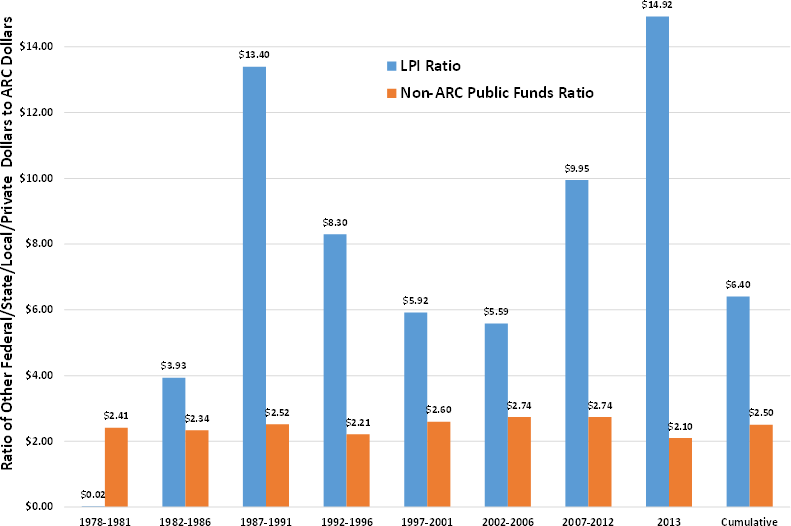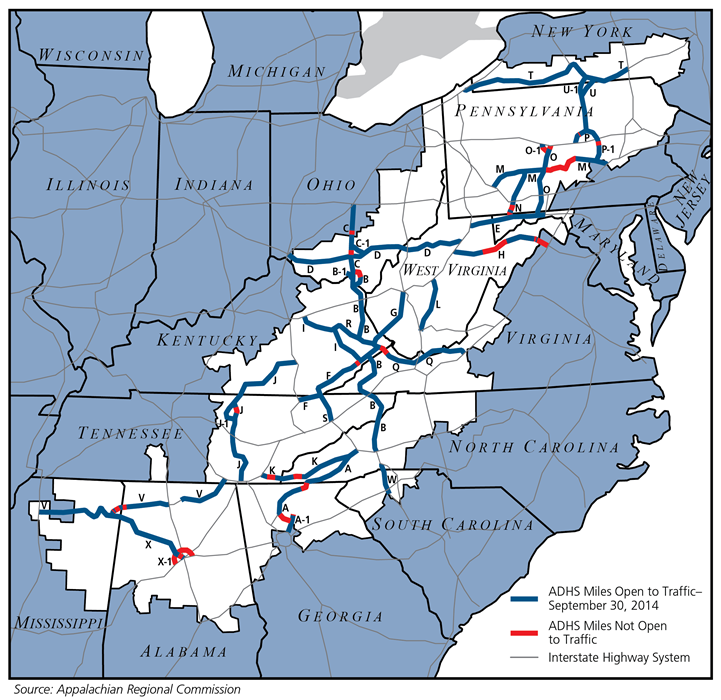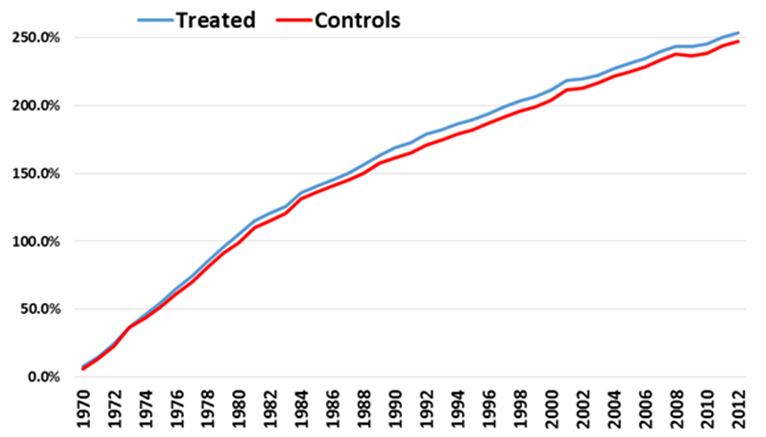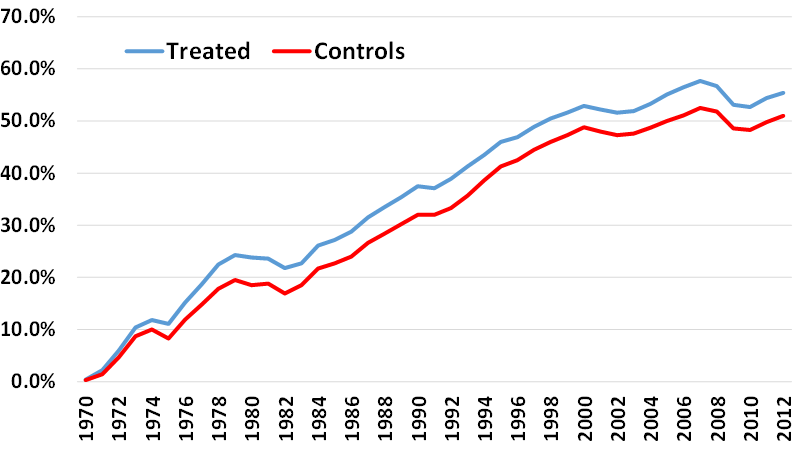



Examining Changes to the Appalachian Region Since 1965
In the late 1950s, intense poverty and economic struggle characterized the existence of many of the 19 million people living in the Appalachian Region.
The magnitude and vastness of Appalachia's challenges, which spread across many states, led to the passage of the Appalachian Regional Development Act (ARDA) in 1965.
The major priorities of ARDA included improving the Region's physical accessibility, developing the Region's economy while reducing dependence on the extraction of natural resources, and enhancing the capability of the Region's people to achieve economic prosperity.
The current boundary of the Appalachian Region includes all of West Virginia and parts of 12 other states: Alabama, Georgia, Kentucky, Maryland, Mississippi, New York, North Carolina, Ohio, Pennsylvania, South Carolina, Tennessee, and Virginia. It covers 205,000 square miles and 420 counties, and is home to more than 25 million Americans. Forty-two percent of the Region's population is rural, compared with 20 percent of the nation's.
ARDA also established the Appalachian Regional Commission (ARC). ARC is a regional economic development agency that represents a partnership of federal, state, and local governments. Its mission is to help the Region achieve socioeconomic parity with the rest of the nation by partnering with the Region and advocating for sustainable community and economic development in Appalachia.
ARC's structure was designed to ensure an active federal-state-local partnership. There are 14 Commission members: the governors of the 13 Appalachian states and a federal co-chair, who is appointed by the president and confirmed by the Senate. Each year one of the 13 governors is elected by the others to serve as states' co-chair of the Commission. Each governor appoints an alternate, who oversees the state's ARC program and serves as the state-level contact for those seeking ARC assistance. Local participation is provided through multi-county local development districts, with boards made up of elected officials, businesspeople, and other local leaders.
Unlike economic development agencies that are primarily grant makers, the Commission also performs advocacy, regional planning, and research activities in combination with its grant programs. These planning and technical assistance activities multiply the influence and shape of ARC's grant programs. No other entity has this regional mandate for Appalachia.
It has now been fifty years since the passage of ARDA. Appalachia has experienced significant progress since then, but still faces persistent challenges. This website serves as a companion, summarizing a research report undertaken for ARC by the Center for Regional Economic Competitiveness (CREC), along with the Regional Research Institute (RRI) and Bureau of Business and Economic Research (BBER) of West Virginia University, to quantify and document changes to Appalachia over the past 50 years, to evaluate ARC's contribution to the Region's economic development during this period, and to assess the extent to which Appalachia remains "a region apart" from the rest of the United States.
In 1964, a report by the President's Appalachian Regional Commission called Appalachia "a region apart—geographically and statistically," adding that the Region had many natural advantages that had benefitted too few of its people. This research uses the same key measures that led to the creation of the Appalachian Regional Commission to determine whether there has been measurable improvement across the Region over the last 50 years.
1. ARC represents a highly valued and active player in the Appalachian Region's economic development, supporting state and local partners in their efforts to transform their communities.

Since 1965, ARC has made nearly 25,000 non-highway strategic investments in the Region. Working with federal, state, and local partners ARC has invested more than $3.8 billion in these projects. These investments supported a variety of community and economic development initiatives, including basic infrastructure improvements, job creation initiatives, and leadership development. For every dollar in ARC funds, state and local partners were able to leverage an average of $2.50 from other federal, state and local funds as well as $6.40 in private sector investments.

In addition, more than $9 billion has been obligated since 1965 for the Appalachian Development Highway System (ADHS), which is now 89 percent complete or under construction. When finished, the 3,090-mile ADHS will connect almost every part of the Region to an interstate-quality highway and to the national Interstate Highway System.
2. ARC has had a significant and important impact on the Region's economic vitality.
Over the past 50 years (with much higher appropriations in the earlier years of the program), ARC's $3.8 billion in non-highway investments have resulted in nearly 312,000 direct, indirect, and induced jobs for the Region and $10.5 billion (in constant 2013 dollars) in additional earnings. Between 2007 and 2013, ARC non-highway investments accounted for nearly 10,000 jobs and $400 million in regional earnings. These impacts do not include the benefits accruing as a result of the investments that ARC has leveraged over the years.

Furthermore, our research demonstrates that counties receiving ARC investments grew at a slightly faster pace than similar counties that did not receive ARC investments. Using a rigorous quasi-experimental research method, our analysis suggests that ARC investments helped counties add employment at a 4.2 percent faster pace, and per-capita income at a 5.5 percent faster pace, than similar counties that did not receive ARC investments.

Moreover, leaders in the Region expressed consensus about the value of ARC's role as a catalyst in helping to make projects happen that might not otherwise have gone forward. In interviews with over 220 local, state, and federal stakeholders in every Appalachian state, ARC was praised for helping leaders respond to uniquely local problems and for its ability to leverage other resources (by seeding new projects or providing the "last dollars" in) when projects did not fit neatly into other funding program models and might not have otherwise happened.
3. ARC has made progress toward helping the Appalachian Region reach socioeconomic parity with the nation, but much work remains in moving some key indicators.
ARC's strategic plan has four major goals: (1) increasing job opportunities and per capita income in the Region; (2) strengthening the capacity of the people of Appalachia to compete in the global economy; (3) developing and improving the Region's infrastructure; and (4) building the ADHS to reduce Appalachia's isolation. On measures related to poverty, income disparity, unemployment, the industrial mix, and housing quality, the Region has improved significantly.
For instance, there has been a dramatic reduction in the number of Appalachian counties where the share of the population living in poverty exceeds 150 percent of the national average. The number of high-poverty counties in the Region (those with poverty rates above 150 percent of the U.S. average) declined from 295 in 1960 to 107 for the period 2008–2012. The overall poverty rate for Appalachia is almost half that of 1960, dropping from over 30 percent to just under 17 percent.
4. ARC has not yet fully accomplished its mission of bringing the Region to parity with the rest of the nation on key socioeconomic indicators.
The Region still lags in many key areas. The Region's population growth is relatively stagnant, reflecting an economy that lags in terms of employment growth and educational attainment so that there are not enough high quality jobs to support its citizens.
Government transfer payments account for one-quarter of all personal income, a 41 percent higher rate than the rest of the nation. By comparison, the ratio was 17 percent after the 1981-82 recession, about 35 percent higher than the rest of the nation. Some, but certainly not all of this increase can be explained by the rise in citizens aged 65 and over now eligible for Social Security.
Furthermore, the Region's citizens have relatively poorer health outcomes (in terms of mortality rates as well the prevalence of obesity and diabetes), reflecting changes in modern-day life that have reduced the quality of life for many residents. In addition, the Region remains relatively more isolated from the rest of the nation because the ADHS is not yet completed and, increasingly, because the Region lags the rest of the nation in access to affordable high-speed broadband service.
Appalachia Moving Forward
The data from this research suggest that ARC has been a vital partner in the economic and community development progress achieved in the Appalachian Region. However, there is a continued need for investment to help Appalachia reach socioeconomic parity with the rest of the nation. Many questions remain about how best to address the challenges Appalachia faces today. How can leaders create a climate of entrepreneurship and opportunity so that local citizens can remain and contribute to Appalachia’s future success? How can the Region compete and succeed in the global economy when it cannot always reach new markets? Few states or localities have the capacity to address these significant challenges without outside help. Addressing the Region’s disparities will require continued local-state-federal partnerships and strategic investments that build opportunity for growth.
The Center for Regional Economic Competitiveness (CREC), along with the Regional Research Institute (RRI) and Bureau of Business and Economic Research (BBER) of West Virginia University were asked by the ARC to quantify and document changes to Appalachia over the past fifty years, evaluate ARC's contribution to the Region's economic development during this time period, and determine to what extent Appalachia still remains "a region apart" from the prosperity typical of the rest of the United States.
This website contains a summary and key findings from the resulting report. To read the full reporting of the results in PDF form, click here.

ARC's mission is to be a strategic partner and advocate for sustainable community and economic development in Appalachia.
The Appalachian Regional Commission (ARC) is a regional economic development agency that represents a partnership of federal, state, and local government. Established by an act of Congress in 1965, ARC is composed of the governors of the 13 Appalachian states and a federal co-chair, who is appointed by the president. Local participation is provided through multi-county local development districts.
For more information about the Appalachian Regional Commission, please visit their web site at www.arc.gov.

The Regional Research Institute at West Virginia University conducts and promotes interdisciplinary research on the economic and social development of lagging regions. The RRI has served as an internationally recognized center for the advancement of Regional Science – an interdisciplinary field at the intersection of geography, economics, and planning.
The West Virginia University Bureau of Business and Economic Research provides the business and policymaking communities with reliable data and rigorous applied economic research and analysis that enables these leaders to design better business practices and public policies.
For more information, visit www.wvu.edu.

The Center for Regional Economic Competitiveness (CREC) was established as a not-for-profit 501(c)3 organization in 2000 to provide research, training, and technical assistance to regions seeking to use fact-based analysis to help design and implement innovative job creation strategies in a knowledge-driven economy. Through its technical assistance and research efforts, the Center helps leaders and organizations to understand the economic forces impacting their regions and their individual roles and responsibilities in promoting economic prosperity. CREC also assists these community stakeholders in formulating transformational strategies to build sustainable regional growth.
For more information, visit www.creconline.org.